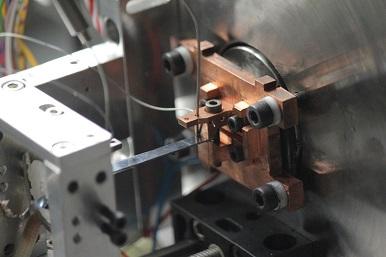Thermoelectricity: Materials and Applications

Thermoelectricity is a class of physical phenomena enabling both the conversion of heat into electricity and the extraction of heat (cooling), in both cases without the use of any movable part. As such, thermoelectric generators are suitable, especially when miniaturized, to harvest low-temperature heat and to make it available as electric power (e.g. to distributed sensor networks or to portable devices). Our research activity focuses both on materials and devices for suitable applications.
Silicon thin films
Energy-selective charge carrier scattering was demonstrated to provide a route to enhance power factor of very heavily boron-doped nanocrystalline silicon films, up to the outstanding value of 40 mW/mK2. Research under way is meant to materials stabilization and to the extension of the process to n-type nanocrystalline silicon films.
Silicon nanowires
Due to its high thermal conductivity, single-crystalline silicon is not suitable as such for thermoelectric applications. Nanostructuration offers effective ways to lower its thermal conductivity. Research is focused on the use of Metal-assisted Chemical Etching (MaCE) as a simple way to obtain Si nanowires (SiNWs). The process, along with the possibility of making electrical contacts localized at Si tips, discloses the opportunity of making bulk-like SiNW pads to be embedded into thermoelectric devices, either for cooling or for heat harvesting.
Paired photovoltaic-thermoelectric harvesters
Photovoltaic (PV) cells only convert a fraction of the solar spectrum, releasing a significant amount of energy as heat. Threfore, solar harvesting might be improved through an accurate coupling of PV cells to thermoelectric generators. Further to energy profitability, hybrid harvesters also meet criteria of economic convenience, which is required for pairing to be practically successful. We mostly work on the direct pairing of specially designed Bi2Te3 thermoelectric generators with perovskite-based photovoltaic cells.
Thermoelectricity under non-stationary conditions
Thermoelectric low efficiencies are basically due to the difficulty of decoupling thermal and electrical conductivity in real systems. Nanotechnology has shown innovative ways to reach such a target. Additionally, thermal and electrical conductivities in bulk thermoelectrics may be uncoupled by operating thermoelectric generators in non-steady state mode. We are exploring how feeding time-modulated heat fluxes may enhanced conversion efficiencies at maximum power.
Principal investigator
Prof. Dario Narducci
Research Lab
U5 Building, 1st Floor, Room 1032-1034
Facilities
- Electron beam evaporator (Kenosistec)
- Furnace for high-temperature annealing (up to 1000 °C) under controlled atmosphere
- Semi-automatic wire bonder (TPT, HB10 model)
- Thermostatic baths (-20 °C – 80 °C)
- Manual lapping systems
- Setup for measuring Hall coefficient as a function of temperature (20 K – 350 K)
- Setup for measuring Seebeck coefficient in thin films
- Setup for measuring current-voltage characteristics in thin films
- Vacuum FTIR spectrophotometer (Brucker VERTEX 70v)
- Z-meter